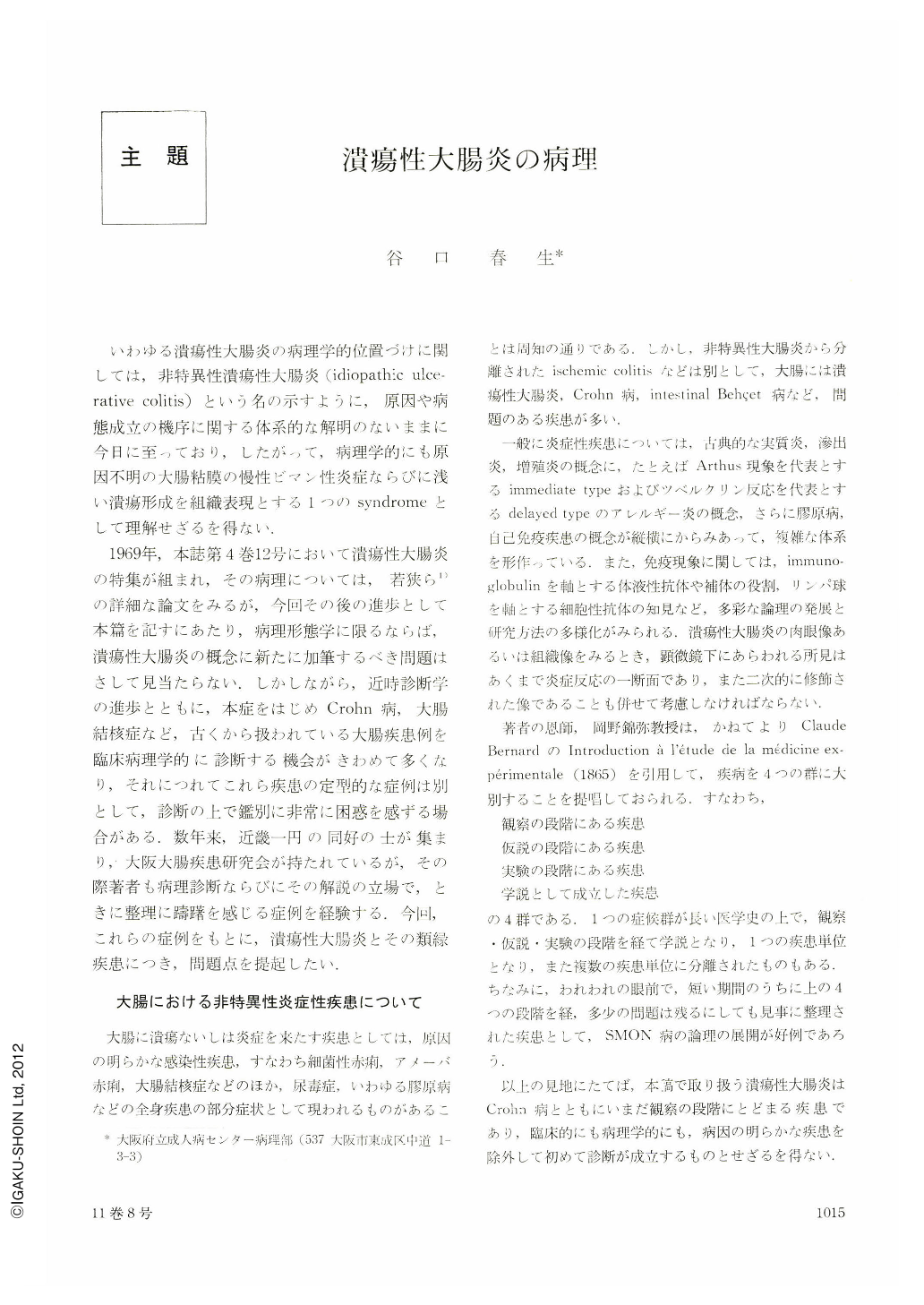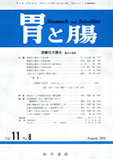Japanese
English
- 有料閲覧
- Abstract 文献概要
- 1ページ目 Look Inside
いわゆる潰瘍性大腸炎の病理学的位置づけに関しては,非特異性潰瘍性大腸炎(idiopathic ulcerative colitis)という名の示すように,原因や病態成立の機序に関する体系的な解明のないままに今日に至っており,したがって,病理学的にも原因不明の大腸粘膜の慢性ビマン性炎症ならびに浅い潰瘍形成を組織表現とする1つのsyndromeとして理解せざるを得ない.
1969年,本誌第4巻12号において潰瘍性大腸炎の特集が組まれ,その病理については,若狭ら1)の詳細な論文をみるが,今回その後の進歩として本篇を記すにあたり,病理形態学に限るならば,潰瘍性大腸炎の概念に新たに加筆するべき問題はさして見当たらない.しかしながら,近時診断学の進歩とともに,本症をはじめCrohn病,大腸結核症など,古くから扱われている大腸疾患例を臨床病理学的に診断する機会がきわめて多くなり,それにつれてこれら疾患の定型的な症例は別として,診断の上で鑑別に非常に困惑を感ずる場合がある.数年来,近畿一円の同好の士が集まり,大阪大腸疾患研究会が持たれているが,その際著者も病理診断ならびにその解説の立場で,ときに整理に躊躇を感じる症例を経験する.今回,これらの症例をもとに,潰瘍性大腸炎とその類縁疾患につき,問題点を提起したい.
Despite the recent developement of medical technology for diagnosis and many reports of clinical studies including the morphological information and research, some of the inflammatory diseases of the large bowel are still remaining in the name as “non-specific” or “idiopathic” for a longstanding history. Ulcerative colitis is also understood as a chronic inflammatory disorder of the large bowel with uncertain origin, which diffusely affect the mucosa combined with shallow ulcers, but the pathology as to what the inflammation trigger is and what factors influence the course of the disease, is still unknown. Therefore, the diagnosis of ulcerative colitis should be made only when the other diseases were ruled out and only when it is enough characteristic for the ulcerative colitis previously reported.
Though many papers have been reported on the morphological change of ulcerative colitis, important things in the diagnosis are the differentiation from Crohn's disease of the large bowel, amebiasis of the colon and colonic tuberculosis especially in Japan. In this study, 2 cases of the resected colon with ulcerative colitis were examined in detail both macroscopically and microscopically with comparative studies on the above colonic diseases.
The histological characteristics of ulcerative colitis are capillarectasis with proliferation, massive infiltration of plasma cells, infiltration of neutrophils, decrease of epithelial goblet cells and crypt abscess. These changes are seen diffusely in the affected colonic mucosa. Above all, the most important is crypt abscess, which appears more frequently in the severely affected portion, and even in mildly affected mucosa, infiltration of the inflammatory cells are seen into the interepithelial space of the crypt, where dissociation between gland and the surrounding interstitium occurs dur to edema. The appeared inflammatory cells were mainly neutrophils in crypt abscess, but plasma cells, lymphocytes and eosinophils were more dominant in the affected mucosa entirely. Crypt abscess was also recognized in the colonic tuberculosis and Crohn's disease of the colon, but the frequency is much rare, and the epithel which encapsulated the abscess was more vivid in tuberculosis than that in ulcerative colitis.
Mucosal surface of cobble-stone appearance in Crohn's disease was glossy, while granular appearance fo the affected portion with remaining mucosa in ulcerative colitis is rather rough due to the inflammatory change.
Biopsic examination in ulcerative colitis is quite useful, because degree of the inflammation in the histological findings generally co-insides with the severeness of the clinical state. Therefore, in the follow-up examination, it is possible to predict more precisely whether it is exacerbating, remitting or remaining in quiescence.
For the pathogenesis of ulcerative colitis, Dr. Uda's work on the relationship between serum immunoglobulin level and the fluorescent microscopic findings of immunoglobulin in the affected colonic mucosa by using fluorescent antibody technic, and also with the electron microscopic findings, was introduced.

Copyright © 1976, Igaku-Shoin Ltd. All rights reserved.


